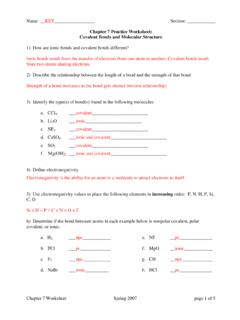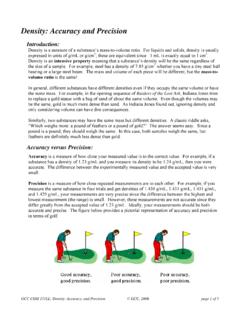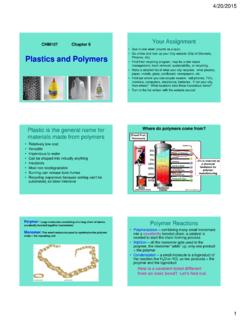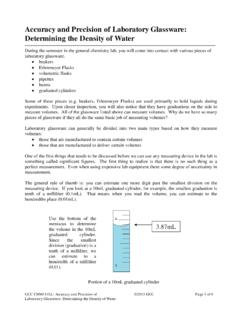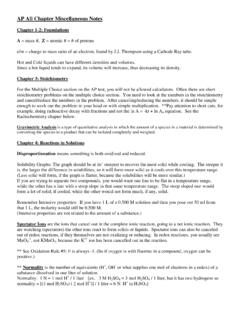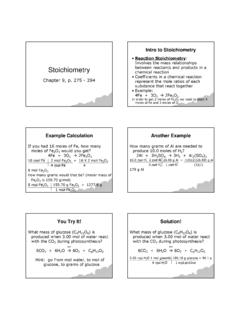Transcription of Chapter 13 Stoichiometry - Glendale Community College
1 Clark, Smith ( ) GCC CHM 130 Chapter 13: Stoichiometry page 1 Chapter 13 Stoichiometry Stoichiometry (STOY-key-OM-etry) problems are based on quantitative relationships between the different substances involved in a chemical reaction. Mole Ratio The coefficients in a balanced equation given the moles of each substance in that equation. For the combination reaction of hydrogen gas and nitrogen gas to produce ammonia, the coefficients give us valuable information about the reaction: N2(g) + 3 H2(g) 2 NH3(g) For every 1 molecule of nitrogen that reacts, it needs three molecules of hydrogen to react with it.
2 Together, they produce 2 molecules of ammonia, NH3. We can also say for every 1 mole of N2 that reacts, 3 moles of H2 reacts with it to produce 2 moles of NH3. These are mole-to-mole relationships/ratios. o Given a balanced equations; any two compounds can be compared using mole-to-mole relationships or mole ratios. C3H8(g) + 5 O2(g) 3 CO2(g) + 4 H2O(g) The mole ratios would be: (3 mol CO25 mol O2) and (1 mol C3H84 mol H2O) and (3 mol CO24 mol H2O) and (5 mol O24 mol H2O) and (5 mol O2 1 mol C3H8) and (3 mol CO2 1 mol C3H8), etc.
3 These mole ratios are used to solve problems such as how many moles of carbon dioxide, CO2, would be produced from moles of oxygen gas? Solution: moles O2 (3 mol CO25 mol O2) = moles CO2 + + YouTube Video: Solving Stoichiometry Problems by weiner7000 STOP at 7:25 until you have read through the next three sections. Clark, Smith ( ) GCC CHM 130 Chapter 13: Stoichiometry page 2 Mass-Mass Stoichiometry Steps: 1) Grams of given moles of given (Use the MM of given as your conversion factor.
4 2) Moles of given moles of unknown (Use mole ratios from balanced equation.) 3) Moles unknown grams unknown (Use the MM of unknown as your conversion factor.) Important to include units & formulas for all substances- units cancel except wanted units. Example: Calculate the mass of H2 required to react with g of O2 according to the following balanced equations: O2(g) + 2 H2(g) 2 H2O(g) Answer: g O2 (1 mol g O2) (2 mol H21 mol O2) ( g H21 mol H2) = g H2 (In your calculator: 2 =) Mass-Volume Stoichiometry OR Recall: Avogadro s Molar Volume is L/mol for a gas only at STP Steps.
5 1) If given grams, use MM as your conversion factor to get to moles of the given -If given volume, use molar volume to get to moles of the given 2) Use mol ratios to convert from moles of given to moles of unknown 3) If asked to find grams, use MM as your conversion factor to get to grams of the unknown -If asked to find volume, use molar volume to get to liters of the unknown Example: How many liters of oxygen gas are needed to react with grams of SO2 gas at STP? 2 SO2(g) + O2(g) 3(g) Answer: g SO2 (1 mol g SO2) (1 mol O22 mol SO2) ( L O21 mol O2) = L O2 (In your calculator.
6 2 =) Molar Mass Mole-Mole Ratio Molar Mass Grams of Given Moles of Given Moles of Unknown Grams of Unknown Molar Mass Mole-Mole Ratio Molar Volume gas @ STP Grams of Given Moles of Given Moles of Unknown Liters of Unknown Molar Mass Mole-Mole Ratio Molar Volume gas @ STP Liters of Given Moles of Given Moles of Unknown Mass of Unknown Clark, Smith ( ) GCC CHM 130 Chapter 13: Stoichiometry page 3 Volume-Volume Stoichiometry Fact: If you start with liters of the given and are asked to find liters of the unknown, as long as the gases are at the same temperature and pressure the molar volumes will cancel out with each other so you are basically just using the mole ratio to solve this type of problem.
7 Example: How many liters of oxygen gas are needed to produce liters of SO3 gas at STP? 2 SO2(g) + O2(g) 3(g) Answer: L SO3 (1 mol L SO3) (1 mol O22 mol SO3) ( L O21 mol O2) = L O2 (notice molar volume cancels out with itself on this problem) L SO3 (1 mol O22 mol SO3) = L O2 Putting them all together you get this chart: Molar Volume gas @ STP Mole-Mole Ratio Molar Volume gas @ STP Liters of Given Moles of Given Moles of Unknown Liters of Unknown YouTube Video.
8 Solving Stoichiometry Problems by weiner7000 CONTIUNUE from for more examples Clark, Smith ( ) GCC CHM 130 Chapter 13: Stoichiometry page 4 Chapter 13 PRACTICE PROBLEMS Example 1: N2 (g) + 3 H2 (g) 2 NH3 (g) A. How many moles of N2 are needed to completely react with moles of H2. B. How many moles of NH3 form when moles of N2 react? C. How many moles of H2 are required to produce moles of NH3? Example 2: Consider the following reaction to produce iron, Fe (s): Fe2O3 (s) + 3 CO (g) 2 Fe (s) + 3 CO2 (g) A.
9 Calculate the mass of CO needed to react completely with g of Fe2O3 . B. Calculate the mass of iron produced when 125 g of CO reacts completely. C. Calculate the mass of CO2 produced when g of iron is produced. Example 3: Calculate the volume (in liters) of oxygen gas required to react with g of aluminum at STP. 4 Al (s) + 3 O2 2 Al2O3 (s) Example 4: An automobile airbag inflates when N2 gas results from the explosive decomposition of sodium azide (NaN3), 2 NaN3 (s) 2 Na (s) + 3 N2 (g) Calculate the mass of NaN3 required to produce L of N2 gas at STP.
10 Answers to Practice Problems Example 1 A 222 Hmol3 Nmol1H moles mol N2 B 232 Nmol1 NHmol2N moles mol NH3 C 323 NHmol2 Hmol3NH moles mol H2 Clark, Smith ( ) GCC CHM 130 Chapter 13: Stoichiometry page 5 Example 2 A g CO B 166 g Fe C = g CO2 Example 3 = L O2 Example 4 g NaN3

